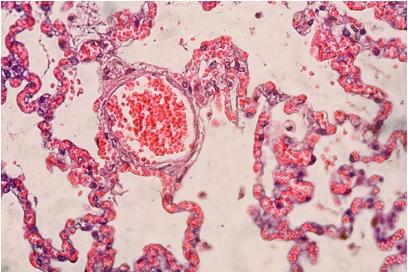The hematoxylin and eosin (H&E) stained tissue section is the cornerstone of anatomical pathology diagnosis. The H&E procedure stains the nucleus and cytoplasm contrasting colors to readily differentiate cellular components.

Though the H&E staining is a relatively simple method to perform, there are a variety of artifacts that can interfere with a good stain. Artifacts can be attributed to a variety of causes.
1. White spots in section after deparaffinization
| Cause | Solution |
| Tissue section not dried enough pre-paraffinization | Incomplete drying: treat with absolute alcohol, retreat with xylene |
| Deparaffinization incomplete (xylene exposure insufficient) | Insufficient xylene exposure: return to xylene, decolourize, restain |
2. The nuclei too pale
| Cause | Solution |
| Not in hematoxylin long enough | Section must be restained |
| Hematoxylin may be overoxidized | |
| Differentiation too long |
3. Nuclei overstained
| Cause | Solution |
| Exposure to hematoxylin too long | If tissue not too thick, decolorize and restain If too thick, re-cut |
| Sections too thick | |
| Differentiation too short |
4. Red, reddish-brown nuclei
| Cause | Solution |
| Hematoxylin old | Use new hematoxylin |
| Section not blued sufficiently | Increase bluing step |
5. Pale eosin staining
| Cause | Solution |
| Eosin pH > 5 (due to bluing carryover) | Adjust pH with acetic acid |
| Section too thin | Remove bluing agent fully |
| Over-dehydrated | Avoid thin cuts/over-dehydration |
6. Cytoplasm overstained
| Cause | Solution |
| Eosin overconcentrated | Dilute eosin |
| Section stained too long | Decrease staining time |
| Insufficient dehydration | Increase dehydration time |
7. Blue-black precipitate on top of section
| Cause | Solution |
| Metallic sheen on hematoxylin solutions deposited on slide | Filter hematoxylin before staining |
8. Water bubbles visible
| Cause | Solution |
| Incomplete dehydration | Remove coverslip/mounting media in xylene, return to absolute alcohol |
| Clear and mount with fresh xylene/mounting agent |
9. Difficulty focusing on some areas
| Cause | Solution |
| Mounting media on top of the coverslip | Remove coverslip, remount with clean coverslip |
10. Mounting media has retracted form edge of coverslip
| Cause | Solution |
| Coverslip warped | Remove coverslip, apply new one with fresh mounting media |
| Mounting media thinned too much with xylene | Ensure mounting media is well-sealed when not in use |
11. Water/Slides turn milky when slides are placed in water following rehydration
| Cause | Solution |
| Xylene not completely removed | Change the alcohols, back slides up to absolute alcohol, dehydrate the sections |
12. Slides are hazy or milky in the last xylene rinse
| Cause | Solution |
| Water in xylene | Change alcohol solutions, especially anhydrous/absolute reagents |
| Re-dehydrate the sections and clear in fresh xylene |
13. Stained/mounted slides do not show usual transparency and crispness under light microscope
| Cause | Solution |
| Mounting media too thick | Remove coverslip and mounting media with xylene |
| Re-mount section with fresh mounting media |
14. Hazy, blue nuclei
| Cause | Solution |
| Too much heat on tissue processor | Heat should only be used during paraffin infiltration |
| Too long in hot paraffin | Tissue should be well fixed prior to dehydration |
| Under-fixed |
15. Uneven H&E staining, nuclei show poor chromatin detail
| Cause | Solution |
| Water/fixative infiltrating paraffin (caused by reagent contamination within tissue processor) | Open processor: substitute toluene for xylene |
| Closed processor: check for malfunction |
16. Dark basophilic staining of nuclei and cytoplasm, especially at tissue edges
| Cause | Solution |
| Heat artifact caused by laser and electrocautery technique | No remedy |
17. Brown stippling resembling pigment, glossy black nuclei
| Cause | Solution |
| Section air-dried before coverslipping | Remove coverslip and mounting media with xylene and rehydrate |
| Allow slide to remain in water several minutes | |
| Dehydrate, clear, remount |